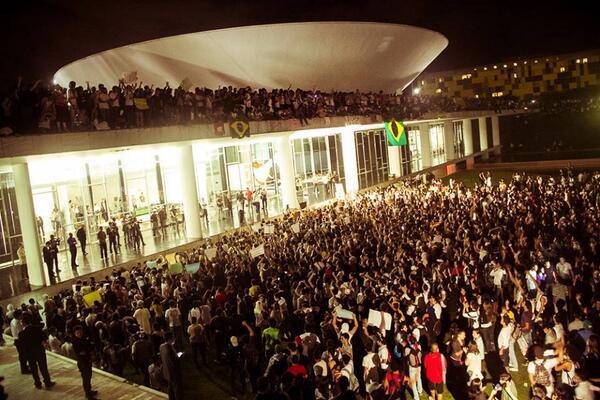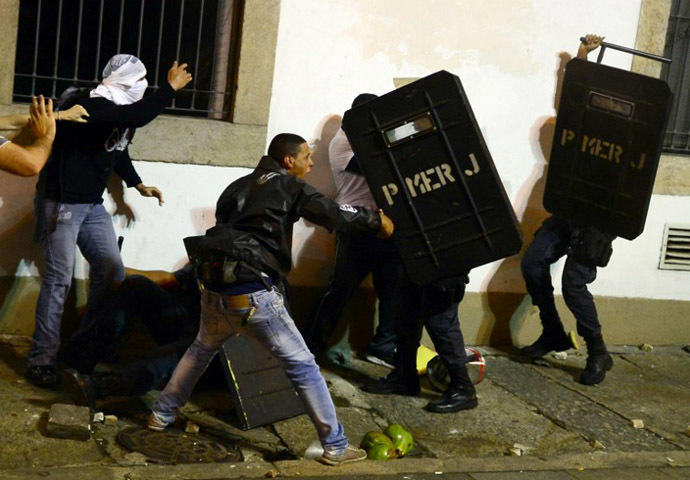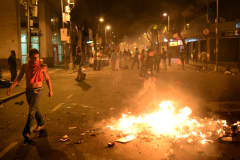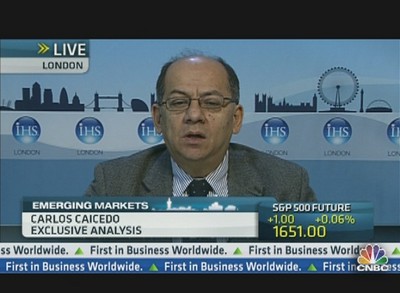http://www.zerohedge.com/news/2013-06-19/brazilian-protests-succeed-reversing-bus-subway-fare-hike
http://rt.com/news/mass-protests-continue-brazil-844/
Though the protests initially began following the announcement of bus fare increases, they have evolved to include a wide range of groups that have grown dissatisfied over everything from government corruption and income inequality, as well as to outrage over the police’s harsh response to protesters last week.
In a sign that public dissatisfaction was still simmering, soccer fans booed president Dilma Rousseff on Monday during the opening of a two-week tournament at a stadium in the capital Brasilia. The heckling only intensified when the president of the global soccer body, FIFA, reprimanded the crowed for failing to show the president “respect.”
http://www.bbc.co.uk/news/world-latin-america-22946736
17 June 2013 Last updated at 20:30 ET
 Huge crowds descended on the Pinheiros area of Sao Paulo for Monday's protest
Huge crowds descended on the Pinheiros area of Sao Paulo for Monday's protest
This past weekend, hundreds of protestors clashed with riot police in the area surrounding the Maracana football stadium in Rio de Janiero. Their main gripe was the fact that the country is spending so much on hosting the 2014 World Cup despite many of the country’s public services still lacking in funding.
Rio de Janiero-based photographer Michel de Souza was at the protests capturing everything on camera, and captured the point-of-view footage above showing what he saw as he snapped photos.
The footage was captured using two GoPro cameras mounted to his DSLRs, and was subsequently edited in a way that shows moments leading up to resulting photographs.
In terms of gear, De Souza was shooting with a Canon 5D Mark II and 16-35mm lens (with a GoPro HERO3 attached), and a Canon 7D and 70-200mm lens (with a GoPro HERO2 attached).
After thousands of people joined in on the protest, riot police were sent to fire tear gas and rubber bullets in order to break up the gathering.
De Souza says that covering the protests was an emotional experience, especially as he was editing the resulting video afterward. “I confess that, towards the end, it moved me to tears,” he tells us.
Here are some of the resulting photographs he captured yesterday:



















You can find a large collection of the resulting photos in this Facebook album.
Brazilian Protests Succeed In Reversing Bus, Subway Fare Hike
Submitted by Tyler Durden on 06/19/2013 18:04 -0400
The Brazilian protests, which swept through the country with the raging bear market (and thepulled mega-IPO) over the past week, and which had the goal of reducing a recent bus-fare increase among other assorted protest goals, appear to have succeeded. At least when it comes to the fare increase. As for the other protester demands, listed below, it may take a little longer.
AP reports:
Brazilian leaders in Sao Paulo say they are reversing a 10-cent hike in bus and subway fares that has sparked widespread protests across the nation.Sao Paulo Mayor Fernando Haddad and Sao Paulo state Gov. Geraldo Alckmin said at a joint news conference Wednesday that the fare increase is now reversed.However, it was not clear what impact the action would have on the protests that have broken out in several Brazilian cities.The protests have evolved into communal outcries that have moved well beyond the original demand that public transportation fares be lowered.Protests are continuing in Rio's sister city Niteroi and in northeastern Brazil.
The good news: protests still work in some cases. The bad news: a 10 cent fare increase is a far more manageable issue to resolve than corruption, violence, police repression, and corrupt politicians which are some of the other protest causes.
Then again, at least the Brazilians are protesting for change: in the US, one only has to consider the epic indignation that the recent NSA spying scandal has unleashed and the mass throngs of people demanding a return of their constitutional rights. Oh wait...
Via Smackson on Reddit, check out this Vine showing the gigantic protester throng.
Brazil Protests (In the Eye of the Storm Video)
Posted on 06/18/2013 by Juan Cole
Brazilians in the hundreds of thousands have been protesting the high cost of city bus tickets, diversion of government funds to international projects like the world cup, and ‘poor public services, police violence and government corruption.’
http://rt.com/news/mass-protests-continue-brazil-844/
Mass protests continued throughout Brazil on Monday, with hundreds of thousands of demonstrators converging in Sao Paulo, Rio de Janeiro, Belo Horizonte, the capital of Brasilia and other cities.
Protests initially began last week following a government announcement of an increase in public transportation costs, which brought out students and young workers and led to more than 250 arrests.
According to reports by Brazilian media such as Jornal do Dia, the initially peaceful demonstrations last week became heated, and led to clashes with Brazil’s riot police that left at least 100 injured in the major cities of Brasilia, Sao Paulo, Rio de Janeiro and Belo Horizonte.
According to reports by Brazilian media such as Jornal do Dia, the initially peaceful demonstrations last week became heated, and led to clashes with Brazil’s riot police that left at least 100 injured in the major cities of Brasilia, Sao Paulo, Rio de Janeiro and Belo Horizonte.
Though the protests initially began following the announcement of bus fare increases, they have evolved to include a wide range of groups that have grown dissatisfied over everything from government corruption and income inequality, as well as to outrage over the police’s harsh response to protesters last week.
In a sign that public dissatisfaction was still simmering, soccer fans booed president Dilma Rousseff on Monday during the opening of a two-week tournament at a stadium in the capital Brasilia. The heckling only intensified when the president of the global soccer body, FIFA, reprimanded the crowed for failing to show the president “respect.”
Though Rousseff was able to ride on her predecessor's popularity, Brazil’s economic growth has slowed considerably since she took over from Luiz Inacio Lula da Silva, who is widely credited with lifting 40 million Brazilians out of poverty. Brazil’s economy has posted its worst two-year performance in over a decade, and inflation rose to 6.5 per cent in May.
At least 20,000 Brazilians were expected to demonstrate in Sao Paulo on Monday, with organizers placing the figure closer to 30,000.
At least 20,000 Brazilians were expected to demonstrate in Sao Paulo on Monday, with organizers placing the figure closer to 30,000.
After Turkey, Brazil Hit by Widespread Protests
http://www.bbc.co.uk/news/world-latin-america-22946736
17 June 2013 Last updated at 20:30 ET
Brazil protests spread in Sao Paulo, Brasilia and Rio
 Huge crowds descended on the Pinheiros area of Sao Paulo for Monday's protest
Huge crowds descended on the Pinheiros area of Sao Paulo for Monday's protest
Tens of thousands of people marched through Brazil's largest city, Sao Paulo, on Monday as protests spread over rising public transport prices and the cost of staging the 2014 World Cup.
Marches took place in several other cities including the capital, Brasilia, where demonstrators climbed onto the roof of the national congress building.
Protesters also clashed with police near Rio de Janeiro's state assembly.
The unrest began last week, after the announcement of increased bus fares.
But the complaints of demonstrators soon extended beyond transport costs when clashes in Sao Paulo led to claims of excessive use of force by police. Dozens of people were hurt, including several journalists.
Since then, protesters have voiced frustration at public transport, security, health and the extent of public investment in two international football tournaments.
The protests have increased since the start of the Confederations Cup on Saturday, seen as a dress rehearsal for the 2014 World Cup.
Standstill
As Monday's protests gathered strength, demonstrators in the capital, Brasilia, breached the high security area of the national congress building, climbing onto the roof of the Oscar Niemeyer-designed structure.
In Sao Paulo, some 65,000 people brought the country's largest city to a standstill, as police stood by and watched.
Security chiefs had met protest organisers earlier in an attempt to avert trouble and announced that regular police would not carry rubber bullet guns at the demonstration.
In Rio, another big crowd took to the streets of the city centre. As protesters reportedly tried to enter the state assembly, police fired rubber bullets and tear gas.
Demonstrators also set fire to a car and lit three bonfires on the streets.
There were also protests in Belem and clashes in Belo Horizonte, as protesters tried to make their way to a stadium hosting a Confederations Cup match between Tahiti and Nigeria.
'Vandals'
The spark for Brazil's escalating protests was a 2 June increase in the price of a single bus fare in Sao Paolo from 3 reals ($1.40, £0.90) to 3.20 reals.
Authorities say the rise is well below inflation, which since the last price increase in January 2011 has been at 15.5%, according to official figures.
Protesters who initially campaigned against bus fares have also expressed anger about inequality and corruption, demanding higher public spending on education and health.
Last Thursday, police fired tear gas and rubber bullets at demonstrators, many of whom were reported hurt.
Dozens of buses and buildings have so far been damaged, prompting Sao Paulo Governor Geraldo Alckmin to describe demonstrators as "vandals".
Before Saturday's opening Confederations Cup match in the capital, Brasilia, protesters tried to approach the Mane Garrincha stadium, but were dispersed by the police.
The following day, a similar march close to the Maracana stadium in Rio, where Mexico were playing Italy, was ended by police with rubber bullets and tear gas.
Eyewitnesses said police had used riot control measures - including firing rubber bullets and tear gas - against peaceful protesters.
Police denied they had acted unlawfully but said they would investigate the allegations.
http://petapixel.com/2013/06/17/a-first-person-view-of-photographing-the-protests-in-brazil/
A First-Person View of Photographing the Protests in Brazil
This past weekend, hundreds of protestors clashed with riot police in the area surrounding the Maracana football stadium in Rio de Janiero. Their main gripe was the fact that the country is spending so much on hosting the 2014 World Cup despite many of the country’s public services still lacking in funding.
Rio de Janiero-based photographer Michel de Souza was at the protests capturing everything on camera, and captured the point-of-view footage above showing what he saw as he snapped photos.
The footage was captured using two GoPro cameras mounted to his DSLRs, and was subsequently edited in a way that shows moments leading up to resulting photographs.
In terms of gear, De Souza was shooting with a Canon 5D Mark II and 16-35mm lens (with a GoPro HERO3 attached), and a Canon 7D and 70-200mm lens (with a GoPro HERO2 attached).
After thousands of people joined in on the protest, riot police were sent to fire tear gas and rubber bullets in order to break up the gathering.
De Souza says that covering the protests was an emotional experience, especially as he was editing the resulting video afterward. “I confess that, towards the end, it moved me to tears,” he tells us.
Here are some of the resulting photographs he captured yesterday:
You can find a large collection of the resulting photos in this Facebook album.













